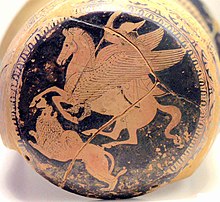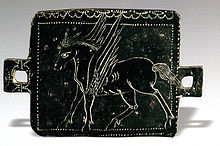Pegasus


In Greek mythology, Pegasus (Greek: Πήγασος (Pégasos)) was a winged horse that was the son of Poseidon, in his role as horse-god, and the Gorgon Medusa. There are two versions of the winged stallion's birth and his brother the giant, Chrysaor:
- One is that they sprang from Medusa's neck as Perseus beheaded her, a "higher" birth, like the birth of Athena from the head of Zeus.
- Another says that they were born of the Earth as Medusa's blood spilled onto it, in which case Poseidon would not be their sire. A variation on this story holds that they were formed from the mingling of Medusa's blood and the sea foam, thus including Poseidon in their making.
Athena caught and tamed Pegasus, and presented him to the Muses at Mount Parnassus. After he became the horse of the Muses, he was at the service of the poets.
Hesiod connects the name Pegasos with the word for "spring, well", pēgē; everywhere the winged horse struck hoof to the earth, an inspiring spring burst forth: one on the Muses' Mount Helicon, the Hippocrene ("horse spring"), at the behest of Poseidon to prevent the mountain swelling too much and another at Troezen. The actual etymology of the name is most likely from Luwian pihassas "lightning", or pihassasas, a weather god (the god of lightning). In Hesiod, Pegasos is still associated with this original significance by carrying the thunderbolts for Zeus.

Pegasus aided the hero Bellerophon (or in later versions Perseus) in his fight against both the Chimera and the Amazons. There are varying tales as to how Bellerophon found Pegasus; the most common says that the hero was told by Polyeidos to sleep in the temple of Athena, where the goddess visited him in the night and presented him with a golden bridle. The next morning, still clutching the bridle, he found Pegasus drinking at the Pierian spring. When the steed saw the bridle, he approached Bellerophon and allowed him to ride. Bellerophon slew the Chimaera on Pegasus' back, and then tried to ride the winged horse to the top of Mount Olympus to see the gods. However, Zeus sent down a gadfly to sting Pegasus, causing Bellerophon to fall all the way back to Earth[1] on the Plain of Aleion ("Wandering"), where he lived out his life in misery as a blinded cripple.
Afterward, Pegasus found sanctuary on the sacred mountain, where he carried Zeus' thunderbolts and was ridden by Eos, the goddess of dawn.
In his later life, Pegasus took a mate, Euippe (or Ocyrrhoe), and had two children Celeris and Melanippe. This family is the origin of the winged horses. Celeris is associated with the constelation Equuleus.

Pegasus was not immortal. Because of his faithful service Zeus honoured him with a constellation.[2] On the last day of his life, when Zeus transformed him into a constellation, a single feather fell to the earth near the city of Tarsus.[citation needed]
In modern terminology, the word "pegasus" (plural "pegasusses" or "pegasi") has come to refer to any winged horse, though the term "pterippus" (meaning winged horse, plural "pterippi") is also used.
Popular Culture
- In 1934 the Magnolia Building in Dallas erected its trademark neon Pegasus that became one of the city's most recognizable landmarks and representative of the city itself.
- In the 1940 animated Disney movie Fantasia, a family of Pegasi are central to "The Pastoral Symphony" segment. The little black foal in the family was so endearing that he was named "Peter Pegasus" by the crew. An animated sequel short was storyboarded but never actually filmed, according to the book Disney That Never Was: The Stories and Art of Five Decades of Unproduced Animation, by Charles Solomon, originally published December 1, 1995.
- Pegasus was a key character in the early 1980s film Clash of the Titans.
- In the 1997 animated Disney movie Hercules, Pegasus is featured as the title character's personal steed and friend. In the movie Pegasus is given to Hercules at birth as a gift from his parents Zeus and Hera.
- Pegasus is the logo of Mobil Oil, a division of ExxonMobil, and the largest provider of gasoline in the United States.
- Pegasus is also the mascot for Team Pegasus a cycling team from Milwaukee, WI and Chicago, IL.
- Pegasus is featured in the video game God of War II (a Playstation 2 game). He helps the main character, Kratos, travel the lair of the Titan Typhon, and then to the Island of Creation.
- On Gosei Sentai Dairanger, Shouji Tenjūsei is called the TenmaRanger or Pegasus Ranger. His Legendary Chi Beast is the Star Tenma/Pegasus.
- In the television series Battlestar Galactica, Pegasus is the name of a Battlestar.
- In the television series Stargate Atlantis, the lost city of the Ancients Atlantis is situated in the distant Pegasus Galaxy, it’s farther than any Stargate team has ever traveled.
- In the anime series Saint Seiya the lead character, Seiya, is bestowed with the Pegasus Sacred Cloth.
- The anime series Damekko Doubutsu features a shy pegasus named Peganosuke.
- In the video game series Fire Emblem, the Pegasus is a species of flying horses. Many are tamed and used as flying mounts for the "Pegasus Knight" and "Falco Knight" classes. Some of the different games in the series adds a bit more detail into the Pegasi themselves.
- Pegasus also played a minor role in the popular anime Sailor Moon, being summoned by Sailor Mini Moon
- Pegasus is also a mythical creature summoned by the Servant Rider in the visual novel and anime series Fate/Stay Night to act as her warsteed.
- Nike, Inc. manufacture a running shoe called 'Air Pegasus'.
- In the most recent Megaman game released into the United States, Megaman Star force, Pegasus was one of the three versions, a major character and provided a powerful transformation to the hero.
- The Pegasus is a plush doll with a code to enter online, now a retired Webkinz
